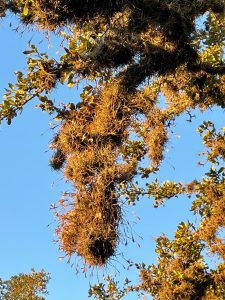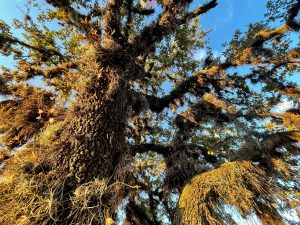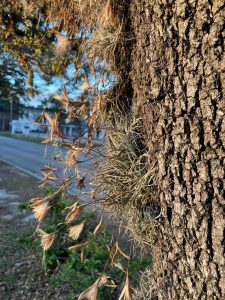
Epiphytes, Greek for “air plants”, defy most of the rules of being a plant. Instead of rooting in the soil, they grow on top of something else, typically in a microhabitat with very little space for roots. No soil is necessary, and they pull nutrients out of the air like tiny green magicians. Air plants tend to do best in humid environments like tropical rainforests and the Deep South, because there is so much water already in the air. The plants trap moisture in tiny hairs called trichomes, absorbing water directly into their leaves. The trichomes also trap dust, which provides nutrients. Air plants can thrive in miniscule amounts of soil/substrate, growing in the crooks of branches, grooves of bark, and even along power lines. The roots of most air plants are minimal, serving more as anchors than sources of nutrition.

Most residents of northwest Florida are familiar with Spanish moss, an air plant in the Tillandsia genus. Because of its reliance on nutrient sources from particulate matter in the surrounding air, Spanish moss is considered an indicator of air quality.

During a recent trip to Louisiana, I came across a tree whose trunk and branches were completely covered in ball moss (Tillandsia recurvata). I am accustomed to seeing a handful of air plants in a tree, particularly in south Florida, but this oak had hundreds nestled in every crevice. A population this dense can cause damage to a tree, adding so much weight that branches can break off. Hand picking plants and pruning off branches is the most recommended practice for handling an overabundance of ball moss. Typically, though, trees will just have a handful of epiphytes.
Ball moss needs bright, but not direct, sunlight, and is adaptable to a wide variety of conditions. It is no surprise that it is the most common epiphyte in Florida. The plant is evergreen and grows in a spherical clump about 3”-6” across. It produces tall, skinny seed heads, which protrude from the leaves and drop seeds—these in turn form colonies of epiphytes. Ball moss is also a very easy plant to grow on your own—it is so low maintenance that adding water and fertilizer can do damage, so it’s best left alone!
 1
1
